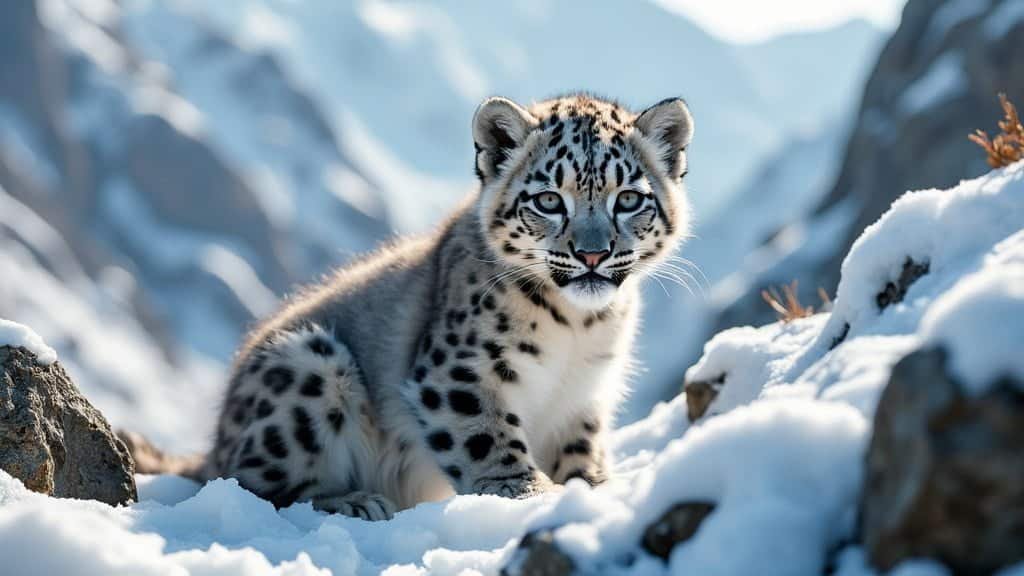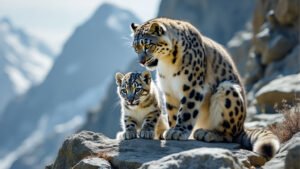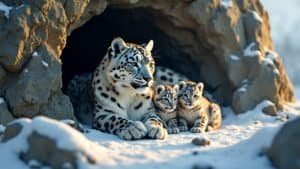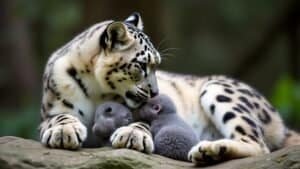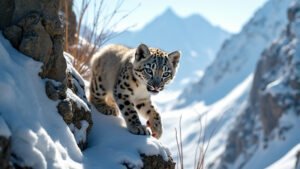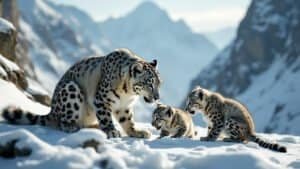Introduction
Snow leopards are elusive and endangered big cats, known for their majestic beauty and challenging mountainous habitats. The survival rate of snow leopard cubs in the wild is a significant concern for conservationists
This article delves into the average survival rates of these cubs, the numerous threats they face, and the importance of prey availability and habitat. Additionally, it highlights various conservation efforts aimed at ensuring their survival
Understanding these factors is crucial for implementing effective strategies to protect these vulnerable cubs and secure their future in the wild
Average Survival Rate of Snow Leopard Cubs
Snow leopard cubs face numerous challenges from the moment they are born, leading to relatively low survival rates in the wild. Their early life is filled with threats, from natural predators to environmental factors and human intervention
Understanding the average survival rate of these cubs and the elements influencing their survival can help conservationists implement targeted strategies to improve their chances
Factors Influencing Survival Rates
The survival rate of snow leopard cubs in the wild varies significantly, but studies suggest that roughly 50% of snow leopard cubs survive their first year. A major factor influencing this rate is the cubs’ dependency on their mothers for food, shelter, and protection
According to research by the Snow Leopard Trust, many cubs do not make it past their first year due to various environmental challenges and predation risks (Snow Leopard Trust, 2020)
Another factor is the scarcity of prey. Snow leopards primarily hunt herbivores such as blue sheep and ibex. When these prey populations decline due to overgrazing by livestock or habitat loss, snow leopard mothers struggle to find enough food to sustain their cubs
This scarcity often leads to starvation or malnutrition in the cubs, greatly reducing their chances of survival. A study published in Biological Conservation noted that prey availability directly correlates with the health and survival rate of snow leopard cubs in the wild (Lovari et al., 2013)
Regional Differences in Survival Rates
Survival rates can also differ based on geographical regions. Snow leopards inhabit a wide range of environments across Central and South Asia, including the Himalayas, the Tibetan Plateau, and the Altai Mountains
Factors such as altitude, temperature, and local prey availability affect survival rates. For example, snow leopards in the eastern Himalayas tend to have lower cub survival rates due to higher human activity and poaching pressures compared to more remote regions like the Pamirs
Conservation experts from Panthera, a leading wild cat conservation organization, emphasize that regional variations in cub survival are critical for understanding and managing local populations (Panthera, 2021)
Comparison With Other Big Cats
When compared to other big cat species, snow leopards have a relatively moderate cub survival rate. For instance, African lion cubs have a survival rate of about 60-70% in their first year, which is higher than that of snow leopards
This discrepancy can be attributed to different environmental conditions and threats. Unlike lions, snow leopards live in harsh, mountainous terrains where food is often scarce, and the weather can be extremely cold. Tigers, on the other hand, face different threats like habitat fragmentation and poaching, but their cub survival rates are closer to those of snow leopards, at about 50-60% in some regions (Karanth et al., 2010)
Understanding these comparisons provides valuable insights into the unique challenges that snow leopard cubs face and highlights the importance of tailored conservation strategies to ensure their survival
The low survival rate of snow leopard cubs is not merely a matter of natural predation or environmental harshness but is deeply intertwined with human impacts and the specific ecological needs of the species
Major Threats to Snow Leopard Cubs in the Wild
Snow leopard cubs face a myriad of threats that significantly impact their survival rates. These threats range from natural predators to human-induced dangers, each playing a critical role in shaping the survival outcomes of young cubs in their harsh, mountainous habitats
Predation and Natural Threats
One of the primary natural threats to snow leopard cubs comes from other predators. While adult snow leopards are apex predators with few natural enemies, their cubs are more vulnerable. Young cubs can fall prey to large birds of prey, wolves, and even other snow leopards
For instance, in the rugged terrains of Mongolia and the Himalayas, golden eagles and wolves are known to prey on young cubs left alone while their mothers hunt. According to a study published in Ecology and Evolution, predation by wolves poses a significant threat to cubs, especially when they are in dens during the early months of life (Johansson et al., 2016)
Additionally, environmental factors such as avalanches, landslides, and harsh weather conditions pose risks to cubs. These natural events can lead to cubs being separated from their mothers or injured, thereby reducing their chances of survival
The remote and steep landscapes where snow leopards live are prone to sudden weather changes, which can be deadly for young cubs who lack the strength and agility of adults
Human-Wildlife Conflict and Poaching
Human activities present some of the most significant threats to snow leopard cubs. Livestock herding in snow leopard habitats often leads to human-wildlife conflict. When snow leopards prey on domestic livestock due to a lack of natural prey, herders may retaliate by killing them
Unfortunately, cubs often become unintended victims in these conflicts. A 2017 study by Global Ecology and Conservation found that retaliatory killings, either by shooting or poisoning, are a leading cause of mortality among snow leopard populations, affecting cub survival indirectly by reducing the number of adult leopards that can rear cubs (Suryawanshi et al., 2017)
Poaching is another severe threat to snow leopards and their cubs. The illegal wildlife trade targets snow leopards for their pelts and bones, and cubs are sometimes captured to be sold in the illegal pet trade
Cubs are particularly vulnerable to poachers because they are easier to capture and transport. The Wildlife Conservation Society has highlighted that poaching contributes significantly to the mortality rates of snow leopards, especially in regions where enforcement of anti-poaching laws is weak (Wildlife Conservation Society, 2018)
Impact of Climate Change on Cub Survival
Climate change poses a long-term threat to snow leopard cubs, altering their natural habitats and the ecosystems they depend on. Rising temperatures and changing precipitation patterns affect the availability of prey species, such as blue sheep and ibex, which are vital for the sustenance of snow leopard families
Reduced prey availability means that snow leopard mothers must cover more extensive areas to find food, leaving cubs unattended for longer periods and increasing their risk of predation
Moreover, climate change is causing the snow line in mountainous regions to recede, leading to habitat fragmentation. Snow leopards are highly adapted to cold, alpine environments, and as these habitats shrink, they are forced into lower, more human-populated areas, escalating human-wildlife conflicts
A study by the World Wildlife Fund (WWF) indicated that climate change could reduce suitable snow leopard habitats by up to 30% by 2070, which could significantly impact cub survival rates due to increased competition and human threats (World Wildlife Fund, 2019)
Understanding these major threats is crucial for developing comprehensive conservation strategies that address both natural and anthropogenic factors. Effective interventions need to mitigate human-wildlife conflict, enforce anti-poaching laws, and adapt conservation strategies to the changing climate to ensure the future of snow leopard cubs in the wild
Role of Prey Availability and Habitat
The availability of prey and the quality of habitat are crucial factors that directly affect the survival of snow leopard cubs. As apex predators, snow leopards rely on a stable and abundant prey base to sustain themselves and their young
Any disruption in prey availability or habitat quality can have dire consequences on cub survival rates, leading to starvation, malnutrition, and increased mortality
Importance of Adequate Prey for Cubs
Snow leopards primarily hunt medium-sized ungulates such as blue sheep, Himalayan tahr, ibex, and argali. These prey species are vital for providing the necessary nutrition that supports the growth and development of snow leopard cubs
Studies have shown that when these prey populations are abundant, snow leopard cubs have higher survival rates because their mothers can hunt more effectively and provide consistent nourishment. According to a study in the Journal of Mammalogy, areas with dense populations of blue sheep and Himalayan tahr reported a higher number of surviving cubs compared to regions with scarce prey (Schaller et al., 2020)
However, overgrazing by livestock, poaching of prey species, and habitat degradation have led to a decline in natural prey availability in many parts of the snow leopard’s range. When natural prey is scarce, snow leopards are forced to hunt livestock, which often brings them into conflict with herders and results in retaliatory killings
This not only impacts adult snow leopards but also their cubs, who suffer due to the loss of their primary caregivers. Effective conservation strategies need to focus on maintaining a healthy prey base to ensure that snow leopards can sustain their cubs
Habitat Fragmentation and Its Effects
Habitat fragmentation is another significant challenge that affects the survival of snow leopard cubs. Snow leopards are solitary and territorial animals that require large expanses of habitat to thrive
Human encroachment, infrastructure development, and mining activities have fragmented snow leopard habitats, restricting their movement and access to prey. Fragmented habitats also limit genetic diversity and increase the likelihood of inbreeding, which can negatively impact cub survival due to inherited genetic weaknesses
Additionally, fragmented habitats often force snow leopards into closer proximity to human settlements. This increases the likelihood of human-wildlife conflicts, poaching, and exposure to diseases that could affect both adult leopards and their cubs
A report by the Snow Leopard Conservancy underscores the importance of creating wildlife corridors and protected areas that connect fragmented habitats to promote safe movement and breeding opportunities for snow leopards (Snow Leopard Conservancy, 2021)
Adaptations of Snow Leopards to Harsh Environments
Snow leopards have evolved several adaptations that help them survive in harsh mountainous environments, and these adaptations also play a role in cub survival. Their thick fur, powerful limbs, and long tail help them navigate steep, rocky terrain and endure frigid temperatures
However, these adaptations are not enough to compensate for the challenges posed by habitat loss and prey scarcity. Snow leopard mothers rely on their knowledge of the terrain and hunting skills to protect and feed their cubs, but when these environments are disturbed, their ability to do so is compromised
Cubs learn essential survival skills from their mothers, such as hunting techniques, territorial navigation, and avoiding predators. When habitats are disturbed or fragmented, cubs may not learn these skills adequately, affecting their long-term survival
The Snow Leopard Network, an international group of conservationists and researchers, emphasizes the importance of preserving natural habitats to ensure cubs are properly equipped with the skills necessary for survival in the wild (Snow Leopard Network, 2022)
Protecting the prey base and habitats of snow leopards is essential for the survival of their cubs. Conservation initiatives must focus on habitat restoration, reducing human encroachment, and promoting coexistence between local communities and snow leopards
By securing a stable prey base and connected habitats, we can enhance the chances of survival for snow leopard cubs and support the overall health of the species
Conservation Efforts to Protect Snow Leopard Cubs
Conservation efforts are crucial in protecting snow leopard cubs and ensuring their survival in the wild
Various organizations, governments, and local communities are working together to address the threats snow leopards face, focusing on reducing human-wildlife conflict, enforcing anti-poaching laws, preserving habitats, and engaging local populations in conservation activities
Community Involvement and Anti-Poaching Laws
Community-based conservation has proven to be one of the most effective strategies in protecting snow leopards and their cubs. Local communities are often the first line of defense against poaching and human-wildlife conflict
Programs like the Snow Leopard Trust’s Snow Leopard Enterprises have successfully involved local communities by providing economic incentives in exchange for their commitment to protecting snow leopards
For example, herders are given compensation and training to develop alternative income sources, such as handicrafts, which reduces their reliance on livestock and, in turn, lowers the chances of retaliatory killings when snow leopards prey on livestock (Snow Leopard Trust, 2019)
Anti-poaching laws are also a critical component of snow leopard conservation. Strict enforcement of wildlife protection laws, including severe penalties for poaching and illegal trade, has shown positive effects in reducing snow leopard killings
Countries within the snow leopard range, such as Mongolia, India, and Kyrgyzstan, have strengthened their wildlife laws and collaborated with international organizations to track and combat poaching networks
For instance, the Global Snow Leopard & Ecosystem Protection Program (GSLEP), launched in 2013, has brought together 12 snow leopard range countries to work on cross-border conservation policies and initiatives (GSLEP, 2020)
Habitat Preservation Initiatives
Preserving and restoring natural habitats is crucial for ensuring the survival of snow leopard cubs. Habitat fragmentation due to infrastructure development, mining, and agriculture poses a significant threat to snow leopards by isolating populations and reducing access to prey
Conservation organizations, such as the World Wildlife Fund (WWF), have been actively involved in promoting policies that limit habitat destruction and promote the creation of protected areas
In Kyrgyzstan, for example, the government has partnered with NGOs to establish the Shamshy Wildlife Sanctuary, a protected area specifically managed for snow leopard conservation. Initiatives like these help secure critical habitats where snow leopards can thrive without the pressure of human encroachment
Moreover, the creation of wildlife corridors—natural pathways that connect fragmented habitats—is essential for maintaining genetic diversity and facilitating safe movement for snow leopards and their cubs across their vast range (WWF, 2021)
Role of International Organizations
International organizations play a pivotal role in snow leopard conservation by providing funding, expertise, and a platform for collaboration among countries
The Snow Leopard Trust, Panthera, and the Snow Leopard Conservancy are among the leading organizations that have developed science-based conservation programs to monitor snow leopard populations, conduct research, and implement community-based conservation strategies
Research and monitoring efforts are fundamental for understanding snow leopard ecology and behavior, which informs effective conservation strategies. The use of camera traps, GPS collars, and genetic analysis allows researchers to estimate population sizes, track movement patterns, and assess genetic diversity
These data-driven approaches enable conservationists to identify critical habitats, high-risk areas, and threats, ensuring that efforts are targeted and effective
Collaborative international efforts like the Global Snow Leopard Forum bring together experts, policymakers, and community leaders to share knowledge, discuss challenges, and develop action plans to protect snow leopards
Such forums and summits have been instrumental in raising awareness about the plight of snow leopards and securing commitments from governments and organizations to allocate resources for their conservation (Global Snow Leopard Forum, 2022)
Conservation efforts are crucial to ensuring the survival of snow leopard cubs and the overall population. Through collaborative actions, strict legal frameworks, community engagement, and innovative research, we can work towards a future where snow leopards continue to roam the high mountains of Asia, and their cubs grow up safely in the wild
Conclusion
The survival rate of snow leopard cubs in the wild is influenced by a combination of natural and human-induced factors
From predation and harsh environmental conditions to human-wildlife conflict, poaching, prey availability, and habitat fragmentation, each element plays a critical role in determining the future of these vulnerable cubs
Understanding these factors helps conservationists develop targeted strategies that address both the immediate and long-term threats to snow leopard cubs
Efforts such as community involvement, strict anti-poaching laws, habitat preservation, and international collaboration are essential for creating a safer environment for snow leopards and their offspring
By focusing on sustainable solutions that balance human needs with wildlife conservation, we can work toward improving the survival rates of snow leopard cubs and ensuring that these majestic cats continue to thrive in their natural habitats for generations to come
